The Performance Center Model 686 is the next step in the evolution of a classic wheel gun.
The first handgun I owned was a Smith & Wesson revolver. I don’t know how many rounds of .38 Special have been through that old Model 10, but it is somewhere in the thousands–each and every one of them having put a smile on my face. But like most handgunners and shooters in general, I probably spend less than 10% of my range time with a wheel gun in my hand nowadays. The “bottom feeders,” as a friend puts it, have taken over the world. But to this day, nothing catches my eye and makes me stop in my tracks like seeing a beautiful revolver. There is something about wheel guns that evoke a feeling of rustic elegance and craftsmanship that is difficult for a modern semi-automatic to match. That old Model 10 with the pinned barrel (yes, I still have it) taught me to love the feel of the “old school” Smith & Wesson action. This new Model 686 from the Performance Center might just have it beat. The people at the Performance Center have released two new variants of the classic Model 686, one is a six-shot 4” barrel version and the other is a seven-shooter with a 5” barrel. This review is based on the 4-inch version.
Performance Center Built
In my garage, safely stowed, is a Chevy Camaro ZL1. Under the hood is a small silver plaque that reads “Chevrolet Performance.” That moniker is far more than a marketing department slap-on sticker. It refers to an independent division of the company that does nothing but make high-performance versions of the brand’s cars. Drive one of each and you’ll immediately feel the difference. So, too, it is with the Performance Center at Smith and Wesson. Their purpose is to take a base model gun and put a master’s touch to its assembly. Sometimes this might just mean extra trigger tuning and exclusive parts—but sometimes it means hand building and cutting, and custom-fit assembly that essentially re-invents the gun and sets it apart from its mass production brethren. I’ve shot a number of 686’s over the years, and they were all good. Some were great. None felt like this one.
For me, the Performance Center (PC) treatment orbits around the feel of the trigger. The action is tuned on each and every gun to improve on what many believe is already the best revolver action in the industry. The action on this example of the 686 is nothing short of excellent. It rolls smoothly and evenly, and I feel no grit or catch in it. Truthfully, it is among the very best I’ve shot. Adding to that experience is the smooth-faced chromed trigger that allows your finger to glide along its arc through the full stroke, and because there is less friction between your finger and the trigger, there is less influence on its break. The tuned action is the most important element of the PC build, but it’s not very visible. Other added elements add not only function but visual aesthetics to the gun.
One of the most noticeable elements of the PC 686 is the vented and ribbed barrel. It dramatically changes the profile of the revolver, making it look more aggressive and more athletic, but it also adds function. The vented rib atop the barrel really does dissipate heat, helping the barrel to run cooler under heavy use, like competition shooting. Sitting atop the vented rib on yet another raised perch is the non-mistakable front sight. This is not your grandfather’s front sight, that’s for sure! This large and very bright orange blade is semi-transparent and makes a highly visible pointer to drop into the rear notch. And if for some reason this one isn’t to your taste, it is replaceable without much effort. Simply drift out a small roll pin and the sight lifts out of the channel that it rests deeply in, and another can be put in its place. I like an orange front sight, so I found it just right. Aft is a fully adjustable rear sight that is blacked out and contains a long ramp that is serrated for anti-glare. Together, they provide an excellent sight picture for both slow or rapid fire.
Smith & Wesson put a championship quality set of sights on the PC 686.
Below the barrel, the folks at the PC have given the ejector rod a long and heavy shroud, which tapers all the way to the muzzle. It’s really a sort of quasi-lug, but is lightened by the taper and a right-side ‘window’ through which part of the ejector rod is visible. I’m convinced this is more about looks than function – and I’m okay with that. It strikes a handsome profile from both sides. Moving back, the unfluted cylinder is separated from the forcing cone by mere thousandths of an inch. It’s difficult to even see daylight at the gap, ensuring that as little energy as possible will bleed off as the shooter touches off a round. This helps maximize both accuracy and power. The unfluted cylinder itself is becoming something of a signature design element of the Smith PC wheel guns. In the satin stainless-steel finish of the Model 686, it is an integral part of the design.
The ejector rod is protected by a handsome shroud. This is important for a competition gun that might not always be handled delicately.
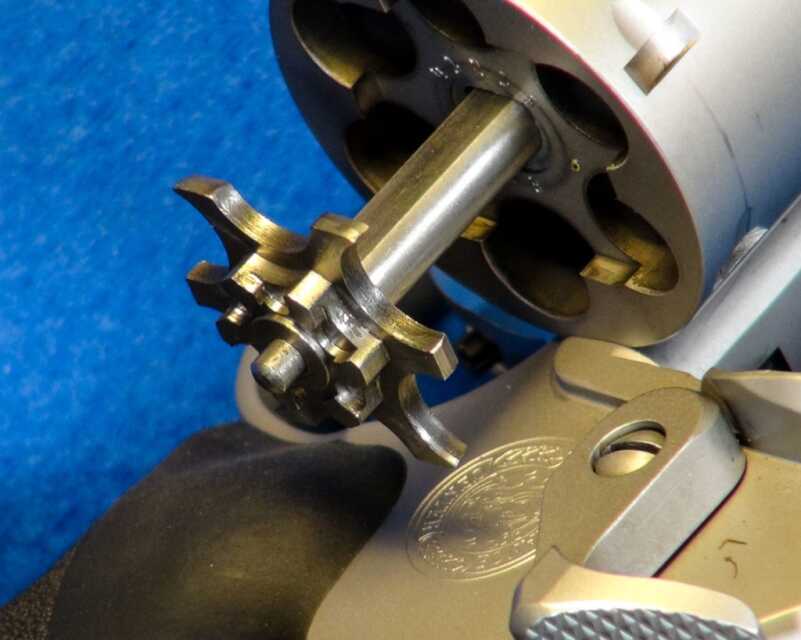
The ejector rod is protected by a handsome shroud. This is important for a competition gun that might not always be handled delicately.
One of the new features on the latest Performance Center 686 family is the addition of the extended cylinder release—called the “Speed Release Thumbpiece” by Smith. This is an in-housing of one of the more popular mods that competitive revolver shooters make to their guns. Smith & Wesson has changed the shape a bit and greatly improved the texture, versus most of the after-market versions. That’s my opinion of course, but that’s what you came here for. The shape mimics that of the hammer spur, which Smith calls teardrop shaped. Reminds me more of an acorn, but toe-may-to/toe-mah-to. It has very aggressive knurling in a deep diamond pattern to match the hammer spur, and that texture provides fantastic traction. And finally, for the shooter’s hand, there is a very comfortable set of Hogue (or Hogue-inspired, Smith’s specs don’t say) rubber grips.
The non-fluted cylinder enhances the clean finish and draws the eye toward more interesting elements.
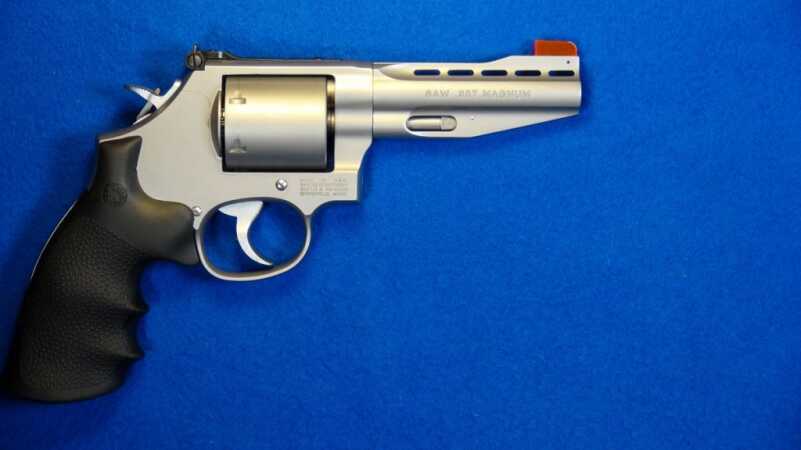
The non-fluted cylinder enhances the clean finish and draws the eye toward more interesting elements.
Shooting the PC Model 686
As I said above, it all starts with the trigger and the feel of the action. When I pick up a Smith & Wesson revolver, I have expectations. I think of over a century and a half of gun making experience by one of the most iconic and well-respected brands in the industry. Those expectations are high. Like most manufacturing companies, Smith & Wesson has had peaks and valleys. One challenge that the industry as a whole faced was the loss of so much institutional skill and knowledge when many of the “old guys” that made all those wonderful guns during the golden years of the ‘40s through the ‘70s retired and took with them their special touch or undocumented know-how. I put six rounds of .38 Special into the cylinder, leveled the gun on target and set my finger onto the trigger to fire it for the first time… and I was impressed.
The vented rib does a noticeable job of keeping the barrel cool. The peek-a-boo window for the ejector rod can help prevent debris from becoming lodged in the channel.

The vented rib does a noticeable job of keeping the barrel cool. The peek-a-boo window for the ejector rod can help prevent debris from becoming lodged in the channel.
The double action is buttery smooth, and the trigger rolls with a consistency and evenness that really caught my attention. I didn’t feel any grit. No tiny catch points in the action. Just a single stroke all the way back until the hammer falls. In fact, I found that most every shot with this gun in double-action is like a surprise break. When I tried to stage the trigger, I actually had trouble doing it – because the pull is so consistent and smooth throughout, you don’t feel a pause point. The action overall is as smooth as ball bearings and the return spring resets the trigger very nicely. My Lyman digital gauge indicates the trigger to have a DA pull of about 10 ¼ lbs. and a SA pull around 4 ½ lbs. Because I spend so much time riding the reset on semi-autos, I can sometimes have trouble with a DA revolver trigger and cause it to bind. That didn’t happen with this one.
A significant part of the quality of the smooth action is owed to the finely milled cylinder ratchet and impeccable timing.
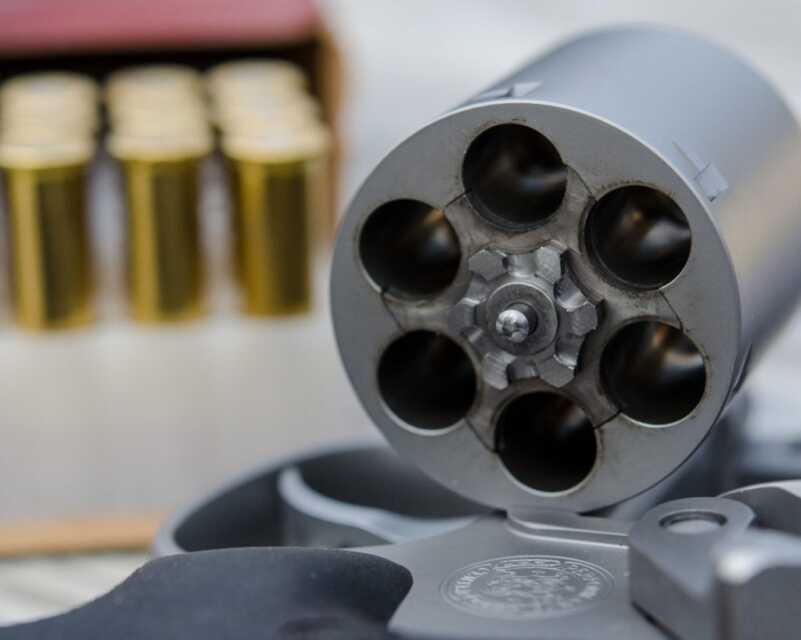
A significant part of the quality of the smooth action is owed to the finely milled cylinder ratchet and impeccable timing.
The sight picture is enhanced by not only the glowing orange slab at the muzzle but the all black rear sight with just enough notch to hold that bright front sight where it belongs. I did most of my shooting at around 10 yards and moved back to 20 for rested groups, and found it well sized for those distances. Beyond 25 yards the blade will begin to obscure your bullseye though. This gun is setup for combat and competition.
The .357 Magnum round can make for a long day at the range in many guns. And I’m not just talking about the Airweight snubbies. I’ve shot many full sized .357 Mag guns that left my hand stinging after just a dozen or so shots. This 686 does a wonderful job of mitigating that recoil. The L-frame offers enough size and weight to absorb much of the energy, and the nicely fitted rubber grips act as shock absorbers. I still preferred shooting .38 Special loads with it, but my lip didn’t quiver when I dropped in six magnums.
Rested groups from 20 yards produced good results. All groups were .357 Magnum loads. Allowing for operator error, I like to focus on the best three shots because I think that better represents what the gun and ammo can do. Three of the four tested ammo brands produced groups well under ¾”. Remington’s 125 gr. was the outlier in the mix. Federal and Fiocchi were a close tie, but I’ve been shooting Federal ammo through Smith & Wesson revolvers so long, that just seems to be a perfect fit.
Just My Opinion
The new pair of Model 686’s from the Performance Center at S&W are far more than a directive from the marketing department to add more SKUs to the catalog. I find them to be highly eye-catching in their design, and the 4” that I tested is just about perfection in revolver shooting. I like the 4” for its balance and traditional profile, but the 5” that holds 7 shots would make a fine alternative. I can’t recall when I’ve felt a trigger and action that were so well tuned from the factory as it is in this model.
Mixing form and function, the Performance Center must be hiring artists as well as engineers.
Aesthetically, the PC 686 is as fine looking a revolver as I’ve seen. The designers have sculptured this hunk of stainless steel into a graceful harmony of lines and curves. From every angle, there is a different nuance of beauty to appreciate—and yet every element has a practical purpose. To re-visit the automotive analogy, beautiful lines and curves are often the product of necessity, finding better ways to manage weight and air flow. So too is the practical beauty with the PC 686. No part is there simply to look good, and no part is there to function regardless of its appearance. Well, maybe the front sight is a little much for some folks… but I don’t mind it at all. Bottom line is if I’m allowed to have just one .357 Magnum—this is it.
The barrel rifling and crown are recessed to protect against damage.
The precision of the cylinder gap at the forcing cone speaks to Smith’s excellent tolerances.
The rubber grips provide both a relief from the high-energy .357 magnum round and a comfortable and sure grip.

The rubber grips provide both a relief from the high-energy .357 magnum round and a comfortable and sure grip.
Visit Smith & Wesson to learn more by clicking HERE.

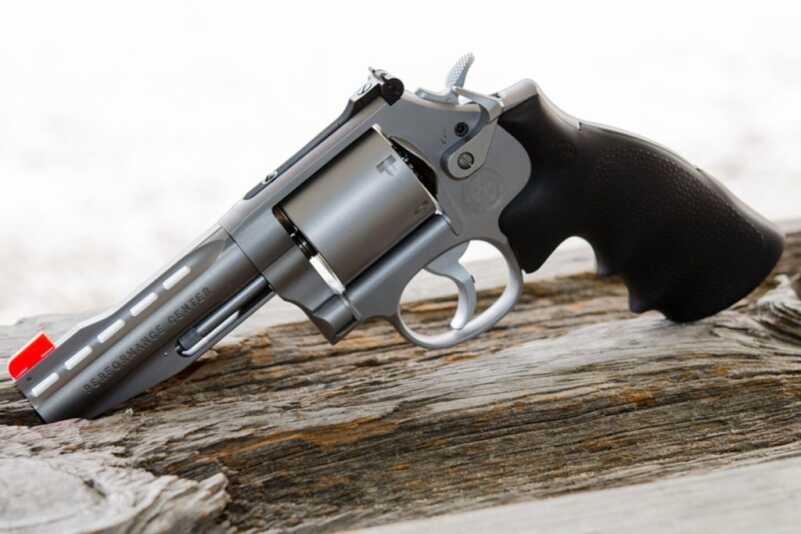

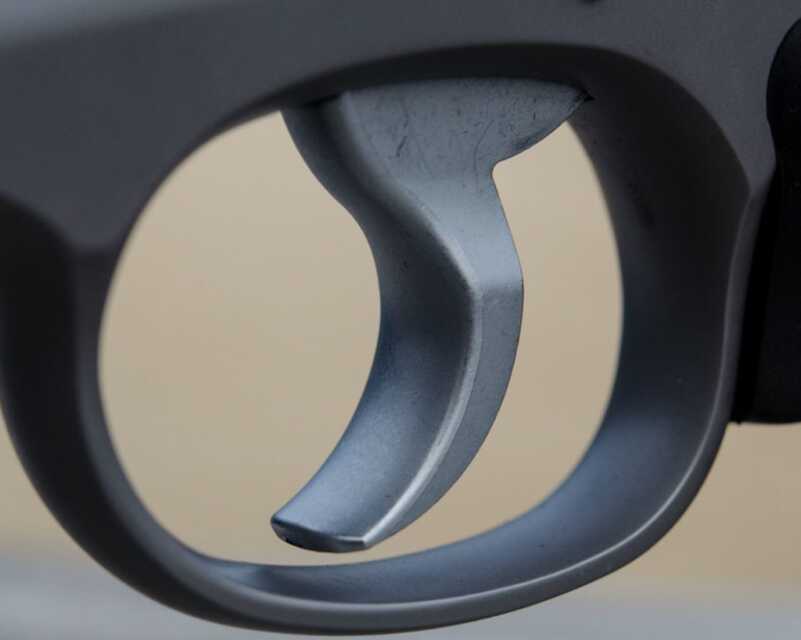
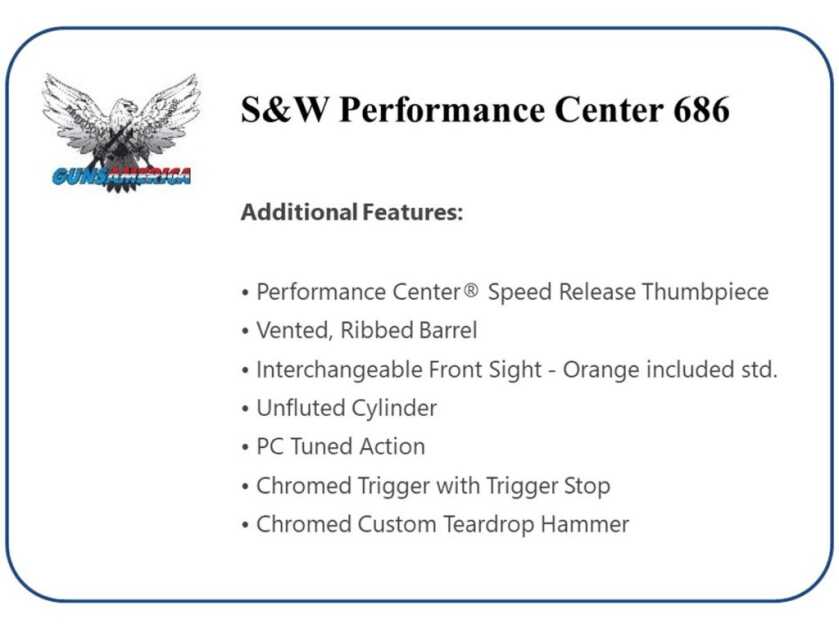
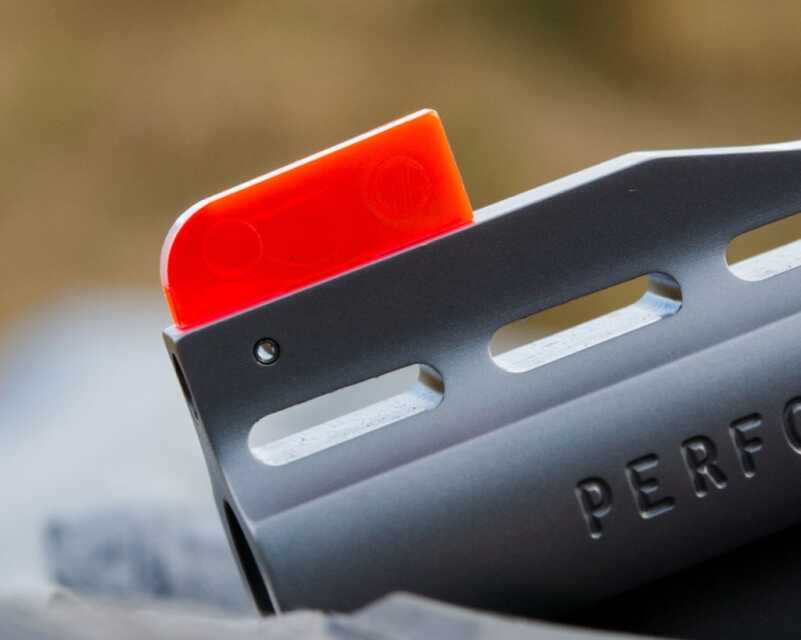


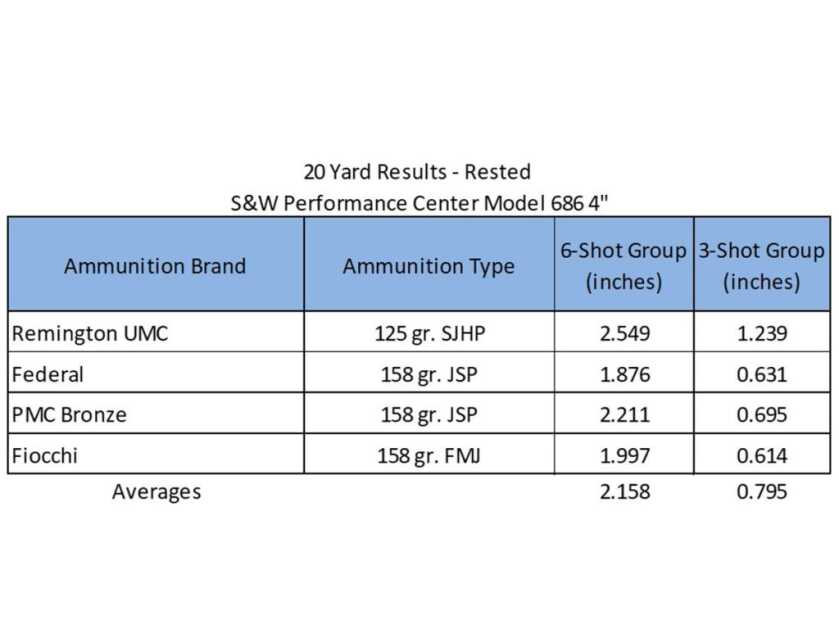

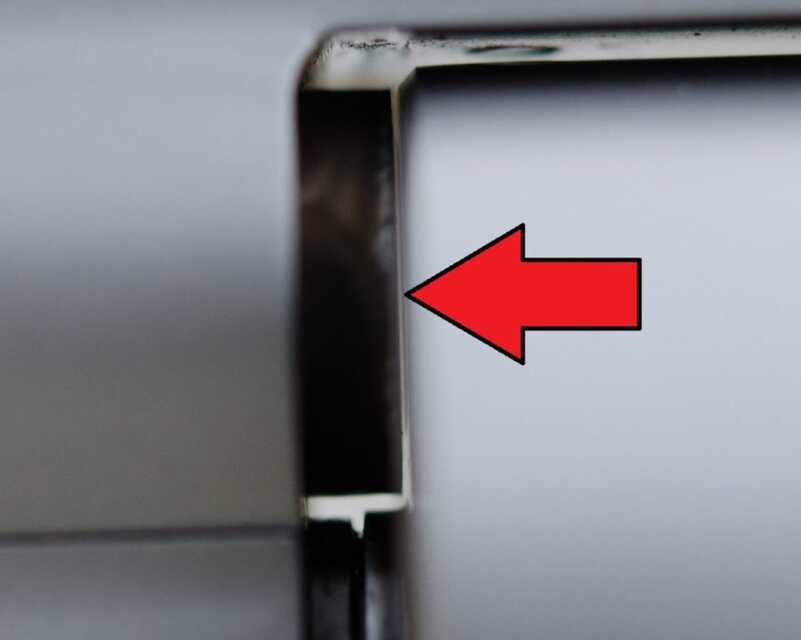
The dull matte finish works for me even though I like shiny revolvers. Much better for hunting and defensive use in a multi-purpose revolver. Maybe an experienced target shooter can explain why there is no white outline on the rear sight of a thousand-dollar target revolver. What possible advantage is there?
The dull satin finish is fine with me even though I love shiny revolvers. Dull is much better for handgun hunting or defensive use and falls under the multiple use trope if you can’t afford six or ten guns. the 7-shot, 5-inch model appeals to me, but can anyone explain the utility of NOT having a white outline on the rear site? How much does a white outline COST?! What is the problem on a thousand-dollar handgun?
The six-shot, four inch barrel version is likely designed for IDPA Stock Service Revolver where no more that six rounds can be loaded in the cylinder and the barrel must be no longer than 4.2 inches. However, under IDPA rules, the cylinder release on this model would have to be replaced with a standard release. Maybe the seven shot is designed for ICORE competition. With the advent of 8-shot, minor power factor revolvers in USPSA-IPSC competition, six (and seven) shot revolvers are now obsolete as dodos.
this guy nailed it. Not to mention Steel Plate Challenge Matches as well…
Sorry that barrel is just too hideous.
Want Smith and Wesson Lady Smith no hammer. in 22mag or 380;
Everybody whining about the “Hillary Hole” claiming that they would never own a revolver with one.
Why not, besides ignorance?
My son just bought a S&W M617 with the “Hillary Hole”.
Guess what?
He unlocked it & tossed the key in the case.
Problem solved.
To each his own, but I really like 686 deluxe in stainless 6″, less of a tricked out look than this one, although I trust this gun is a fantastic shooter. I think S&W makes very good guns and classy looking revolvers , maybe not this one but maybe it could grow on a guy once he shot it.
357 is a great caliber through and through, most versatile gun I own for sure.
Good review. Have the 4″ 686 Plus (7 rounds of 38 Special or .357 Magnum) and a 4″ 617 (10 rounds of .22 Long and same weight and size as 686 Plus) and have loved them since purchase. Both have the Hillary Hole but got over it as soon as I started shooting them.
I have never been attracted to the looks on the Performance Center version of the 4″ 686 since it only carries 6 rounds, cylinder is not fluted and I do not like the ejector rod shroud. But, everybody’s different. Of all of the things I own, the 686 Plus and the 617 will NEVER be sold…..but passed down for sure.
I’m sure the S&W is a quality revolver, but I rather have the Dan Wesson 715. Better fit and finish, better trigger, ability to swap barrels and looks better in my opinion.
It needs to be moon clip ready to interest me!
Though I shoot and enjoy semi-auto pistols in Steel Challenge competitions, at heart this old Neanderthal is still a revolver FREAK. So after first glance at Smith’s 4″ 686+ Pro Series .357, I WANTED ONE; the perfect excuse to reacquaint with the .357 Mag cartridge after a three-decade separation due to Big-Bore Fever. I knew if Smith ever offered a longer barrel than 4″ I wouldn’t be able to resist. Lo and behold, VIOLA, out comes a 5″ 686+! So I sold my soul to afford one!
I consider Felicia to be The World’s Most Gorgeous .357; but in this case, beauty is NOT just skin-deep! With revolvers I do all accuracy testing by shooting full-cylinder groups, which means SEVEN-SHOT groups with Felicia (suffice to say much easier said, than done well).
To better realize any guns’ accuracy potentials I scope them, including most pistols. With the benefit of a 3X T/C pistol scope, my 5″ 686 Plus’ BEST 25 yard group to date chewed-out a lovely, symmetrical, single hole measuring just ..68″ center-to-center; the group completely covered by a quarter! That said, she AVERAGES sub-1″ seven-shot groups at 25 yards, and sub-2″ at 50.
As I understand it, the Pro Series guns get a little of the ‘pixie dust’ sprinkled more liberally on Smiths’ Performance Center guns. Frankly, the 686 Pro Series .357s are much more attractive looking than the Performance Center versions (that are actually too GAUDY). Not sure if my attempt to copy and paste a photo here will work, but if so, here’s proof-positive.
2/3″ 686 group.JPG
I bought a Smith & Wesson 686 357 Magnum over 3 decades ago. It is my favorite revolver hands down. Kind of big to carry but a great shooting gun.
I have a model 66-6 F-Comp. It has the hole and the lock. Very nice handgun,except for the lock and the hole in the side.Only S-W that I have. Will not buy another with the hole in the side. Just do not like that feature.Given the chance to sell it for a good price I will do so. I hope in the future this will be removed from all the Smith-Wesson revolvers .
I have two rubs with this revolver, both involving the cylinder, and neither having anything to do with the ‘Hillary Hole’. If they can make it a seven shooter with the 5″ barrel, then why not the four inch also? Secondly why-o-why did they not flute the cylinder? Cleaner lines? Gimme a break. Hopefully, anyone willing to lay down that much money for a new revolver plans on carrying it. For me, the 4″ barrel is the maximum I’m willing to pack, and a seven shooter trumps a six shooter with monotonous regularity. Is anybody listening? As for the Hillary Hole, as ugly as it is it still represents engineering changes that allows for the shooting of heavier loads in the J, K and L frames. I can live with it. For all the oceans of ink wasted whining about it, I have yet to hear of a single documented S&W revolver failure as a direct consequence of the Hillary Hole. This latest incarnation of the 686 has me intrigued, and I’ll be looking to see if S&W will indeed bestow us with a 4″, seven shooter in this latest 686 variation.
How does the lock allow for the shooting of heavier loads?
And sadly, it still has one useless and incredibly unattractive feature that I (and countless others) simply can NOT accept – yes, that damn lock. I swore I\’d never own one. I\’ve stayed the course with only one moment of weakness – an associate needed to raise some cash for a build and was selling a rarely used model 29 to do so. I bought it and you would have too – hey, he priced it. I immediately found an interested party and we worked out a trade – I\’m the proud new owner of a nice Ruger Super Redhawk \”Alaskan\” (also in .44mag) and I still have no S&W\’s with that \”Hillary-hole\”.
Excellent name Hillary hole.
I am with you, I love the old S&W revolvers and have a few but I refuse to purchase any new S&W revolvers with the Hillary hole.
I totally agree but you can modify the gun with a plug and take out all the attendant lock system fairly easily…. I like the looks and function of the S&W’s so went the extra step. I have a 686, 618 and 637 sans hole now and with the plug you almost forget they were ever there.
The finish is HORRIBLE! Just ME, I guess, but that’s unacceptable.